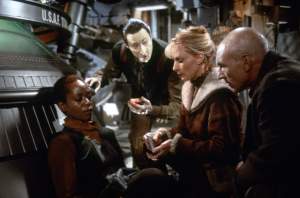Sega Dreamcast

Interneteable/Shutterstock
The Sega Dreamcast had a lot of things working against it, least of all that it was released just a year before the juggernaut that was the PlayStation 2. Coming just four years after the wet fart named the Sega Saturn, the Dreamcast is arguably the most underrated home console in gaming history. The library is varied and extensive (particularly impressive given the console’s brief shelf life) and was one of the first North American consoles to offer any kind of online services. The Visual Memory Unit, or VMU, was also ahead of its time — acting as a memory card and lo-fi portable gaming unit. It is a console any serious collector should own.
Playstation

v74/shutterstock
The Sony PlayStation, released in 1995 in North America, is important not only because it popularized the CD-ROM as the primary format for video game titles but also because it kicked off a massive rebalance of power in the console industry. Within two console generations, not only would the Sega vs Nintendo debate be a thing of the past, but Sega would give up on consoles altogether and Nintendo would lean into their new identity as the weirdo in 3rd place.
The console has a massive library, though many games in this generation have aged poorly as non-Nintendo developers struggled to grasp working in three dimensions. Still, the industry would look quite different without the success of the OG PlayStation.
Switch

Niphon Subsri/Shutterstock
With the Switch, Nintendo continued its recent pivot away from chasing graphical excellence and towards innovation and broad appeal. Combining the best parts of the Wii and the Game Boy handheld, the Switch is buoyed by its stellar first-party titles and a deep library of cheaper digital games that non-PC gamers might have never played. Being able to seamlessly switch (I see what they did there) from playing on your TV to going handheld on the train with no loss in performance is still impressive, even seven years after its release. They even managed to retain some of the motion controls that made the Wii such a huge hit.
Nintendo 64

Robtek/Shutterstock
The biggest mark against the Nintendo 64 is the shockingly small game library and overall lack of third-party support. Just under 400 titles were released in North America, compared to the nearly 1300 for the PS1 or even the 700 for the SNES.
Still, many of the games we did get ranked among the greatest in the history of the medium, and helped define the industry’s move from two dimensions and sprites to three dimensions and polygons. Don’t forget that picking up the N64’s unique controller and playing Mario 64 in 1996 was most people’s first time using an analog stick.
PS4

Anthony McLaughlin/Shutterstock
The second best-selling console in history, the PlayStation 4 finds itself on this list for one simple reason: it has a fantastic game library. With about 2,000 titles released (about 300 of which are exclusive to the system), the PlayStation 4 is home to banger after banger since its launch in 2013. And while its rival the Xbox One measures up or even succeeds Sony’s hardware in the broadest technical sense, with only 59 exclusive titles it finishes in a close second place in the eighth console generation. The biggest bit of criticism one could make of the PS4 is that the original version of the console was very, very loud.
Wii

Tinxi/Shutterstock
At a time when everyone else was pushing the limits of what was graphically possible, Nintendo made the brilliant decision to focus on accessibility and fun. Though less technically impressive than its generational competitors, the Wii saw huge success in becoming the gaming system for people who don’t play video games. With its simplified controller and focus on local multiplayer, its most successful games were something everyone in the family could confidently pick up and play. Its best-selling game, Wii Sports, with its bundle of motion control mini-games stands out as the best example of everything the console was about. That doesn’t mean it lacks games for actual gamers either, with Mario Galaxy in particular standing out as one of the best titles Nintendo has ever produced.
XBOX

julie deshaies/Shutterstock
Released in November of 2001, Microsoft’s first Xbox console ushered in two major milestones in console gaming history. First, its massively successful launch title Halo: Combat Evolved did for console first-person shooter games what Mario 64 did for 3D platforming. Finally, an FPS you could play alongside a controller that felt right.
Second, and most importantly, the Xbox eventually brought us Xbox Live and popularized playing console games online. Sure, this was nothing new to PC gamers, but for everyone else, this was a mindblowing new feature that quickly made online multiplayer the main draw for games and changed the entire industry.
NES

PitStock/Shutterstock
The Nintendo Entertainment System launched in North America in 1985 and completely revitalized what was believed to be a dead industry. Sure, most of the revered, classic games seem quaint now with their simple controls and limited, 8-bit music and graphics, but many of them still hold up and are worth playing at least once or twice on the Switch’s virtual console.
Better yet, track down a refurbished system and a couple of cartridges from your local used game store to get the authentic experience. You can’t call yourself a “real gamer” unless you’ve spent twenty minutes blowing into a cartridge and fidgeting with the reset button to get your original copy of Ducktales to finally power on correctly.
PlayStation 2

Deni Williams/Shutterstock
The PlayStation 2 is the best-selling video game console of all time for a reason: the game library is excellent. Though it wasn’t as simple to set up and use as an Xbox, the PS2 allowed online play with an adapter. It was aesthetically pleasing, and could be displayed vertically or horizontally (the PS logo on the front would rotate to remain upright).
Also important to its success is that the PS2 doubled as a DVD player. At its price point, for many Americans, the PS2 became the cheapest way to watch DVDs and helped kick off the mass consumer migration away from VHS in 2001. It was a true game changer that cemented Sony’s dominance at the top of the console landscape where it remains to this day.
SNES

Shutterstock
The Super Nintendo Entertainment System improved upon its progenitor in every way possible. The graphics were better, the music was clearer, and the controller felt more comfortable in the hand. Nintendo even changed to a top-loading system so we never had to encounter a flashing solid blue screen or blow into a cartridge ever again (except for when we did).
The SNES arguably has the strongest library of any game in history. The 16-bit style has aged wonderfully, and most of the games are just as fun and engaging to play now as they were in the early and mid-90s. It doesn’t get much better than the Super Nintendo. Pure video game joy.







